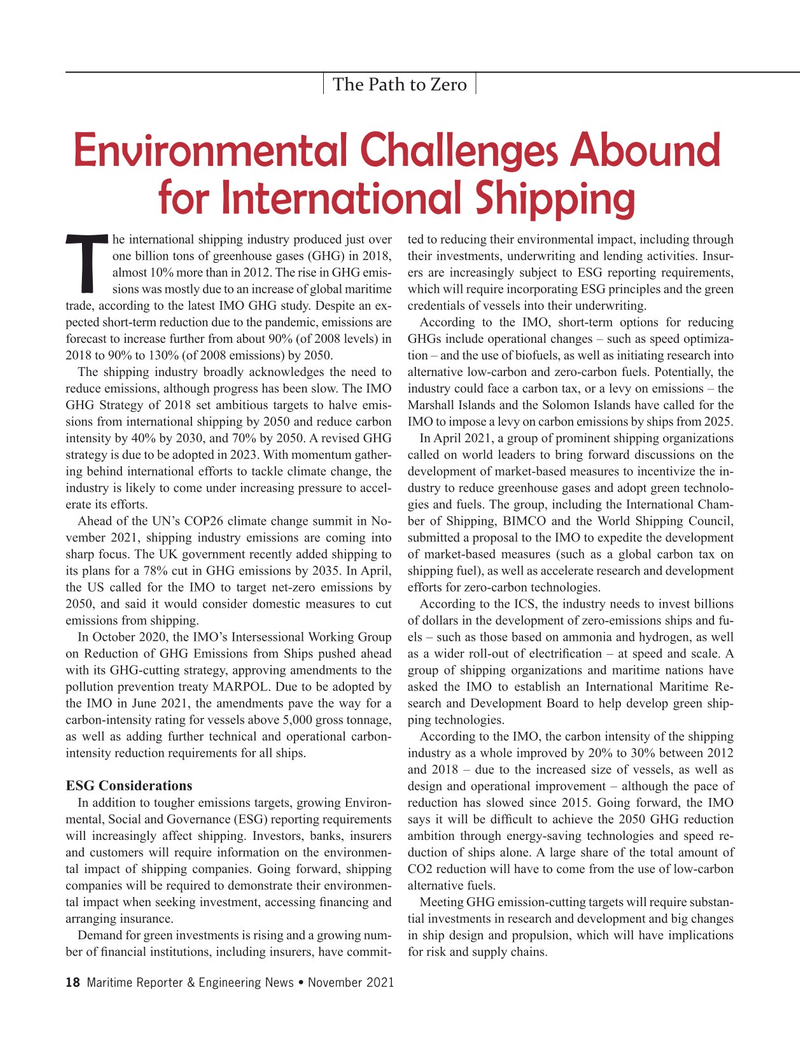
Page 18: of Maritime Reporter Magazine (November 2021)
The Workboat Edition
Read this page in Pdf, Flash or Html5 edition of November 2021 Maritime Reporter Magazine
The Path to Zero
Environmental Challenges Abound for International Shipping he international shipping industry produced just over ted to reducing their environmental impact, including through one billion tons of greenhouse gases (GHG) in 2018, their investments, underwriting and lending activities. Insur- almost 10% more than in 2012. The rise in GHG emis- ers are increasingly subject to ESG reporting requirements,
T sions was mostly due to an increase of global maritime which will require incorporating ESG principles and the green trade, according to the latest IMO GHG study. Despite an ex- credentials of vessels into their underwriting.
pected short-term reduction due to the pandemic, emissions are According to the IMO, short-term options for reducing forecast to increase further from about 90% (of 2008 levels) in GHGs include operational changes – such as speed optimiza- 2018 to 90% to 130% (of 2008 emissions) by 2050. tion – and the use of biofuels, as well as initiating research into
The shipping industry broadly acknowledges the need to alternative low-carbon and zero-carbon fuels. Potentially, the reduce emissions, although progress has been slow. The IMO industry could face a carbon tax, or a levy on emissions – the
GHG Strategy of 2018 set ambitious targets to halve emis- Marshall Islands and the Solomon Islands have called for the sions from international shipping by 2050 and reduce carbon IMO to impose a levy on carbon emissions by ships from 2025. intensity by 40% by 2030, and 70% by 2050. A revised GHG In April 2021, a group of prominent shipping organizations strategy is due to be adopted in 2023. With momentum gather- called on world leaders to bring forward discussions on the ing behind international efforts to tackle climate change, the development of market-based measures to incentivize the in- industry is likely to come under increasing pressure to accel- dustry to reduce greenhouse gases and adopt green technolo- erate its efforts. gies and fuels. The group, including the International Cham-
Ahead of the UN’s COP26 climate change summit in No- ber of Shipping, BIMCO and the World Shipping Council, vember 2021, shipping industry emissions are coming into submitted a proposal to the IMO to expedite the development sharp focus. The UK government recently added shipping to of market-based measures (such as a global carbon tax on its plans for a 78% cut in GHG emissions by 2035. In April, shipping fuel), as well as accelerate research and development the US called for the IMO to target net-zero emissions by efforts for zero-carbon technologies.
2050, and said it would consider domestic measures to cut According to the ICS, the industry needs to invest billions emissions from shipping. of dollars in the development of zero-emissions ships and fu-
In October 2020, the IMO’s Intersessional Working Group els – such as those based on ammonia and hydrogen, as well on Reduction of GHG Emissions from Ships pushed ahead as a wider roll-out of electri? cation – at speed and scale. A with its GHG-cutting strategy, approving amendments to the group of shipping organizations and maritime nations have pollution prevention treaty MARPOL. Due to be adopted by asked the IMO to establish an International Maritime Re- the IMO in June 2021, the amendments pave the way for a search and Development Board to help develop green ship- carbon-intensity rating for vessels above 5,000 gross tonnage, ping technologies.
as well as adding further technical and operational carbon- According to the IMO, the carbon intensity of the shipping intensity reduction requirements for all ships. industry as a whole improved by 20% to 30% between 2012 and 2018 – due to the increased size of vessels, as well as
ESG Considerations design and operational improvement – although the pace of
In addition to tougher emissions targets, growing Environ- reduction has slowed since 2015. Going forward, the IMO mental, Social and Governance (ESG) reporting requirements says it will be dif? cult to achieve the 2050 GHG reduction will increasingly affect shipping. Investors, banks, insurers ambition through energy-saving technologies and speed re- and customers will require information on the environmen- duction of ships alone. A large share of the total amount of tal impact of shipping companies. Going forward, shipping CO2 reduction will have to come from the use of low-carbon companies will be required to demonstrate their environmen- alternative fuels. tal impact when seeking investment, accessing ? nancing and Meeting GHG emission-cutting targets will require substan- arranging insurance. tial investments in research and development and big changes
Demand for green investments is rising and a growing num- in ship design and propulsion, which will have implications ber of ? nancial institutions, including insurers, have commit- for risk and supply chains. 18 Maritime Reporter & Engineering News • November 2021
MR #11 (18-33).indd 18 11/4/2021 9:38:42 AM

 17
17

 19
19
